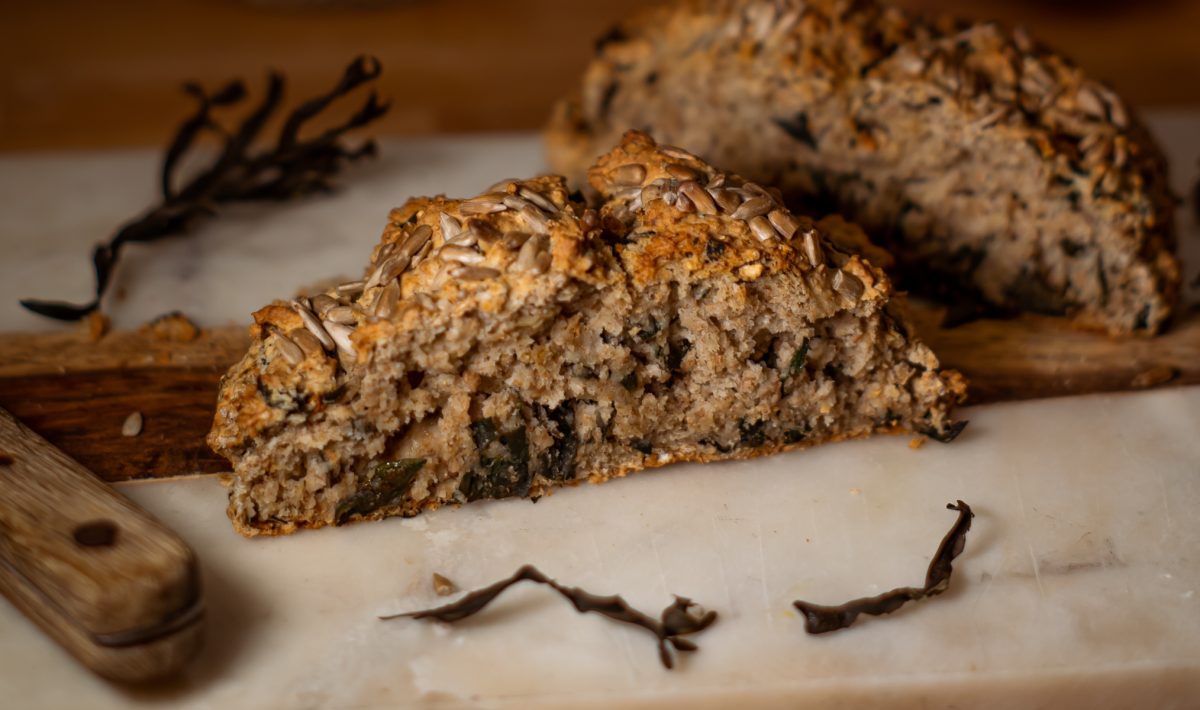On our last adventure to Holland we happend to come across some fresh sea oak on the wave breakers of Zeeland. Once back home, I decided to dry most of it for later use on the radiator, but I kept some of the fresh stuff for a little experimentation, including this soda bread.
Loaf of the Vikings?
I’m a big fan of soda bread Mainly because it takes hardly any time to make, and it’s the perfect way to use up some leftover yoghurt or (butter)milk. Mix wet and dry ingredients, some seeds and, in this case, freshly harvested seaweed, and in one hour you’ve got yourself a delicious, savoury bread. Soda bread is a rather soft, crumbly bread, so don’t expect a crunchy crust.
The addition of the sea oak – you can use other seaweed as well – adds a naturally salty flavour that goes well with the earthy flavour of the walnut oil and sunflower seeds.
Soda bread is a famous Irish staple. Ireland’s climate is only suitable for ‘soft wheat’ varieties, which don’t make good yeast bread due to a lack of gluten. Hence the use of baking soda and buttermilk that act as the leavening agents, causing the bread to rise. But where did they get the idea? I was surprised to discover that it was actually Native Americans who first baked a type of soda bread, using pearl ash, a natural form of soda formed from the ashes of wood, to leaven their bread without yeast. It got me thinking: maybe the Vikings had brought the technology back with and established its use on the Emerald Isle. I was dead wrong.
Turns out that the “ancient” tradition of Irish soda bread didn’t even make it to Ireland until around the time of the great potato famine. This devastating event led to almost 40% of the Irish population dying or leaving the country. It had overwhelming effects on the human geography of the the country, and this led to massive social change too. After losing the potatoes that had dominated their diets, the people searched for alternatives and discovered soda bread. The loss of one traditional staple, left room for another, and with it, gave birth to a new heritage and cuisine.
Why this bread?
Traditionally a soda bread has a cross like incision at the top. It helps with baking the bread, but there is also a superstitious element to this tradition. Irish families believed that if they cut a cross on the top of the bread, it would ward off evil spirits and protect the household from harm. I like to imagine that Irish or Scottish fishermen clung to this custom as well to keep them safe while out on the sea. And as we head into 2022, and all of the trips we have planned, I thought we might benefit from such a good omen.
Another reason why I wanted to try this seed and seaweed soda bread was that Donald from the Seaweed chef told us that seaweed can be used as a healthy alternative to salt. You can find an interesting article on this topic on the website of Mara Seaweed, one of the places we are planning to visit during our UK trip.
Soda bread with goat cheese and a seaweed pickle
Once baked we topped it off with a soft goat cheese and a seaweed, cucumber pickle. The seaweed pickle was my second fresh seaweed tryout of the day and turned out to be a rather nice compliment to the bread.
The crumbly soda bread, soft goat cheese and tangy pickle paired nicely for our lunch!


Seed and seaweed sodabread
Ingredients
- 500 grams spelt flour
- 50 grams linseed
- 1 ts baking soda
- 1 ts sea salt
- 500 ml buttermilk you can also use yoghurt or almondmilk
- 1 ts apple cider vinegar or lemon juice
- 60 ml walnut oil or olive oil
- 50 grams sea oak washed and chopped
- 4 tbs sunflower seeds
Instructions
- Mix the flour, linseed, salt and baking soda together.
- Mix the buttermilk, vinegar and walnut oil.
- Pour the dry ingredients into the wet ingredients, add the chopped sea oak and mix everything together briefly until just mixed and you get a 'shaggy' dough.
- Place the dough on a baking tray lined with baking paper and shape it into a flat heap. Cut a cross across the top of the bread. Brush the top with a little extra milk and sprinkle with seeds.
- Bake the bread for 40 minutes at 180°C and lower the temperature to 160°C for the last 10 minutes. Bake the bread until cooked through and the crust is nice and golden brown.Let cool for at least 30 minutes before serving the bread.
original recipe : https://emptythefridge.be/recept/iers-sodabrood/






Recent Comments